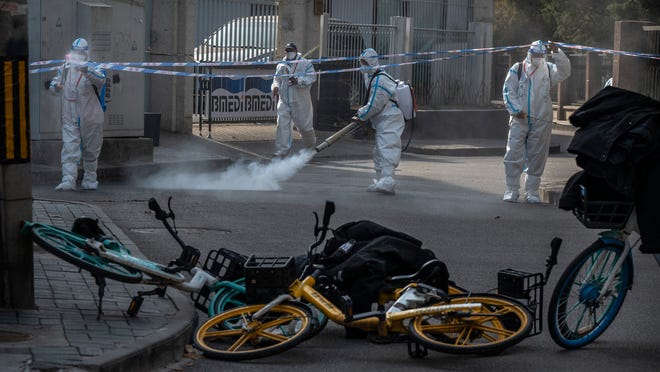- The CDC issued a “Level 2” travel health notice noting that monkeypox cases had been reported in Europe, North America and Australia.
- The CDC advises travelers to wash their hands often with soap and water or use hand sanitizer, as well as keep their hands away from their face.
- While the CDC has issued a monkeypox notice, the agency said that “risk to the general public is low.”
The Centers for Disease Control and Prevention is warning travelers to “practice enhanced precautions” as monkeypox spreads.
Monkeypox, a disease that results from infection with the monkeypox virus, a viral illness in the same family as smallpox, has been identified in 16 countries across the globe, including the United States.
The CDC, which issued the Level 2 travel health notice Friday, said on its website that cases had been reported in Europe, North America and Australia.
According to the World Health Organization, “monkeypox virus is transmitted from one person to another by close contact with lesions, body fluids, respiratory droplets and contaminated materials such as bedding.”
For decades, monkeypox has been seen in parts of Central and West Africa and believed to jump occasionally from animals, likely rodents, to people. Typically, several travelers a year arrive in the U.S. and Europe infected with the virus, but such a large chain of person-to-person transmission has never been seen before.
“None of these people reported having recently been in central or west African countries where monkeypox usually occurs, including the Democratic Republic of the Congo and Nigeria, among others,” the CDC said in its travel health notice.
The agency said that the “risk to the general public is low.”
Here’s what we know:WHO convenes meetings, steps up response on ‘atypical’ surge in monkeypox cases
President Joe Biden:US has enough vaccines to deal with monkeypox outbreak
What precautions to take if you’re traveling
The CDC advised travelers to avoid:
- Close contact with sick people – including people with skin or genital lesions, and contact with materials used by sick people or animals such as clothing, bedding or health care materials.
- Contact with dead or live animals such as small mammals, including rodents like rats or squirrels, and nonhuman primates such as monkeys and apes.
- Eating or preparing wild game meat or using products that come from wild animals from Africa, such as creams, powders and lotions.
The CDC also advises travelers to wash their hands often with soap and water or use hand sanitizer and keep their hands away from their face.
And if travelers develop a new and unexplained rash (with or without chills and fever), they should avoid contact with other people. The CDC also advises travelers to call ahead before seeking medical attention and, if they can’t call ahead, to tell staff upon arrival that they have concerns about monkeypox.
When visiting a health care facility for treatment, the CDC said, travelers should tell the doctor whether they have had contact with someone who might have had monkeypox and whether they were in an area where monkeypox has been reported or is commonly found in the month before symptoms appeared.
Biden on monkeypox:‘Everybody’ should be concerned, spread would be ‘consequential’
Where has monkeypox been identified?
As a part of the health notice, the CDC listed the countries in which cases of monkeypox have been identified:
- United States
- Canada
- Australia
- Belgium
- Austria
- England
- France
- Germany
- Italy
- Netherlands
- Portugal
- Sweden
- Spain
- Switzerland
- Scotland
- Israel
The health agency also listed some countries where monkeypox is common, including:
- Democratic Republic of the Congo
- Republic of the Congo
- Central African Republic
- Nigeria
- Cameroon
- Côte d’Ivoire
- Sierra Leone
- Sudan
- Gabon
Opinion:Monkeypox is here and spreading. But the US is well prepared to handle the threat
As of Monday in the U.S., there was one confirmed case of monkeypox in Massachusetts, CDC spokesperson Dave Daigle told USA TODAY Tuesday. There are an additional four cases of orthopox that the CDC is doing “confirmatory testing” on.
Daigle said states test for orthopoxvirus, the genus to which monkeypox belongs, according to the CDC.
How does monkeypox appear and spread?
While monkeypox is in the same family as smallpox, it is far less dangerous. It appears first as a flu-like illness, with fever, muscle aches and malaise, followed by skin lesions, though the rash may appear first, said Capt. Jennifer McQuiston, a veterinarian and deputy director of the CDC’s Division of High Consequence Pathogens and Pathology.
The incubation period for monkeypox is typically six to 13 days but can be anywhere from 5 to 21 days, according to WHO.
Unlike most known cases of monkeypox, where the telltale rash usually appears first on the hands, among current cases many rashes are first appearing around the genitals or anus, CDC officials said in a news conference.
Monkeypox is not as easily transmissible as viruses like SARS-CoV-2, which is responsible for the COVID-19 pandemic. But a lesion in the mouth could lead someone to spew viral particles when talking or coughing, though it is not typically considered a respiratory virus.
Of nine known cases of people infected with the virus who traveled from Nigeria before the outbreak, none passed it to others on the plane or through casual contact, McQuiston said.
“This is not an easily transmissible virus,” she said. “This is not COVID.”
Contributing: Karen Weintraub, USA TODAY
